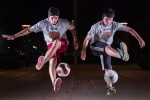There’s white lab coats and long lab hours, then there’s freestyle football.
Peter and Daniel Azzam are brothers pursuing their dreams in the medical field as fourth-year physical sciences and third-year neuroscience students, respectively.
They are also professional freestyle football athletes.
The brothers started Bruin Freestyle Soccer Academy at UCLA in fall 2013, a club that teaches basic freestyling techniques while helping members incorporate their own unique styles. Now, the two will start their own group – named “Innovation” – to focus more on giving volunteer freestyle football performances, educating people about the sport and providing other enthusiasts with a platform for creativity.
Freestyle football developed about 10 years ago as a new sport in which athletes “juggle” a soccer ball using different body parts. There are toe bounces, which many soccer players do, and advanced techniques, such as handstands while keeping the soccer ball on their backs. The main difference between soccer and freestyle football is the creative nuances and innovative techniques freestyle football athletes use.
Freestyle football combines elements of dance and acrobatics with a ball. Unlike soccer, which is objectively scored, freestyle football is like a performing art, and is thus evaluated by a judge. There is a varied set of techniques that judges look at: musicality, difficulty, creativity, style, execution and – when in a battle – responsiveness to the opponent.
There is a strong synergy between the athlete and the ball – athletes fuse their individuality into the sport whether it is a choreographed routine or an improvisation. When Daniel saw this connection between his older brother and the ball, he also became drawn to it.
“When my brother Peter started freestyling a year before me, I wanted to get into it as well,” the younger Azzam said.
Both brothers said that they felt restricted with their abilities and creative personalities on their high school soccer team. After Daniel was repeatedly benched for his spontaneous tricks on the field, he decided to pursue freestyling.
“It is all about creativity for me,” he said.
Daniel followed the footsteps of his older brother, who had quit the high school team for the same reason a year earlier. Peter said he loved watching freestyling videos online ever since he found out about the sport in a World Cup commercial. When he decided to try it himself, he was practicing five hours a day, making mistakes but enjoying the progress he made. Combining both passion and discipline, Peter now owns a few signature moves himself.
Although the brothers started freestyling at different times, they now regularly practice new tricks together and motivate each other.
“I wouldn’t have started without him. Seeing him do it made me want to do it,” Daniel said.
When the two first started freestyling, they did not know of a community in Los Angeles that shared their enthusiasm. The first few years were spent in their old condo’s parking garage by themselves.
“At times, it gets really hard to keep on doing what you are doing because there are not many people who are doing it,” Peter said.
But now, Daniel and Peter identify themselves with a community of freestyle football athletes who come together to practice their new tricks and to inspire each other.
When Daniel placed third in the 2013 North American Freestyle Football Championship in December, in which freestyle football athletes from Canada, the United States, Jamaica and Mexico come to compete, Peter said he was happy for his younger brother’s achievement.
Kathy Azzam, the mother of the brothers, who is supportive of their passion, said that wasn’t the case in the beginning.
“At first, it was very hard to support something that was so new and unfamiliar to me, but they have amazed me with what they’ve accomplished. I am proud to be the mother of two freestylers,” Kathy said.
The Azzam brothers will continue their journey as freestyle football athletes and look to expand the community of freestylers. They will first focus on sharing the sport in the United States, but their ultimate goal is to tour around the world.
“I see the way that this inspires people, and I am really happy with that,” Peter said. “So I want to keep doing what I want to do.”
